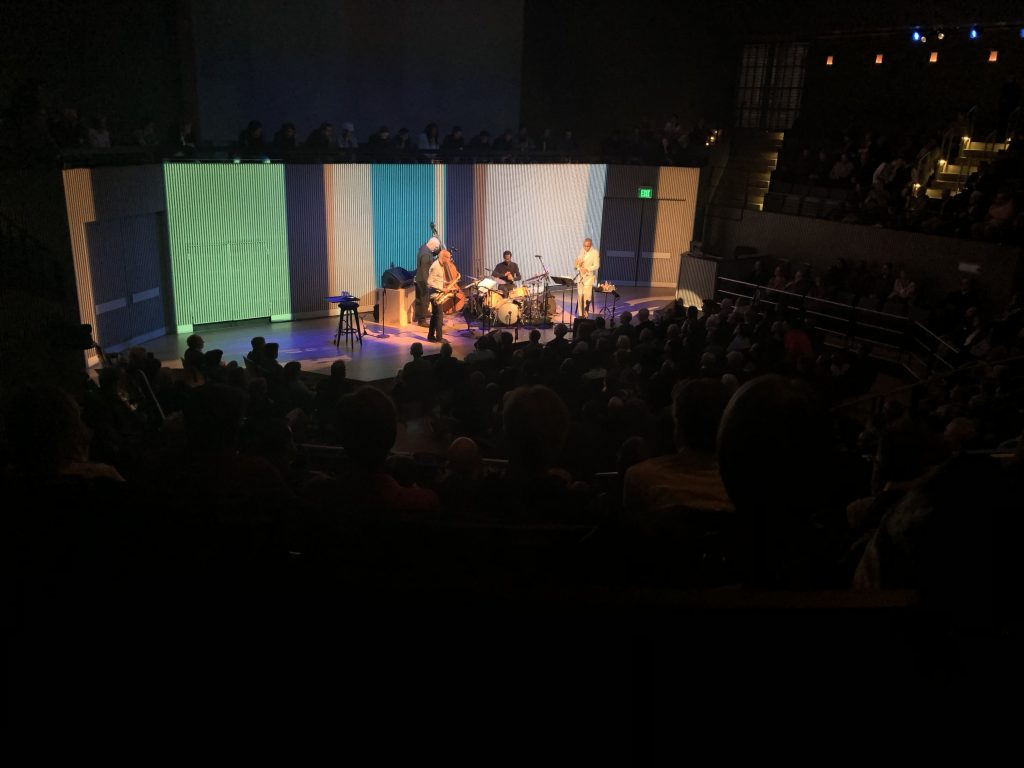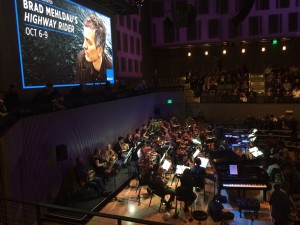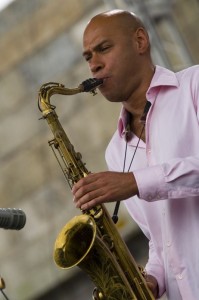Jazz tenor saxophonist Joshua Redman is bringing a new level of challenge and innovation to his audience. I saw Redman and his quartet perform last week at SF Jazz, where they played songs from their new album Still Dreaming.
The quartet is made up of all-star drummer Brian Blade, cornetist Ron Miles, and bassist Scott Colley and represents a nod to Redman’s father’s quartet Old and New Dreams, a band that played from the mid-1970s to the mid-’80s, with Dewey Redman on tenor saxophone like his son.
At the heart of the music is the interplay between Redman on saxophone and Miles on cornet (basically a tiny trumpet). The two alternate among harmonizing, playing together in discordant fashion, taking turns with solo pieces and melodies, and playing simultaneously almost like two people talking past each other.
Filling in the spaces is the incredible percussion of Blade, perhaps most famous for providing the solo drum soundtrack to the Academy Award-winning movie Birdman with Michael Keaton. Colley on bass provides solid grooves, tasteful melodies, and guitar-like solos.
 At Friday’s concert, they opened with the contemplative album-concluding track The Rest (video above), then segued into the upbeat New Year opening track. Along the way, they played Redman’s newish song “Facts” (written in January 2017 around the time of Trump’s inauguration) and Last Rites of Rock n’ Roll, a song Redman said he grew to hate performing until this new band played it. He opened that song with a long solo intro featuring circular breathing (continuous playing by breathing in through the nose while simultaneously breathing out into the horn).
At Friday’s concert, they opened with the contemplative album-concluding track The Rest (video above), then segued into the upbeat New Year opening track. Along the way, they played Redman’s newish song “Facts” (written in January 2017 around the time of Trump’s inauguration) and Last Rites of Rock n’ Roll, a song Redman said he grew to hate performing until this new band played it. He opened that song with a long solo intro featuring circular breathing (continuous playing by breathing in through the nose while simultaneously breathing out into the horn).
The band also covered Ornette Coleman’s Broken Shadows. The music overall is reminiscent of Coleman’s avant garde approach to jazz, with broken melodies and seeming off-notes, a kind of musical deconstruction. They then concluded with an encore performance of the bluesy Turnaround, from Redman’s early 1990s album Wish.
Redman’s new work and accompanying performance is not meant to get the audience toe-tapping or to revel in solo pyrotechnics. Instead, the songs are thoughtful, intellectual, and full of emotional and sonic range (particularly using quiet as a sound). It’s a challenging but enjoyable experience that stays with you long after the show ends.
Brad Mehldau’s masterpiece “Highway Rider” is the centerpiece of SF Jazz’s 5th season, performed in full from Thursday through this Sunday, October 9th. Highway Rider is a concept album from 2010 that essentially chronicles the journey of “John Boy” (the first track) on a life journey that becomes cyclical. The album features Joshua Redman on tenor and soprano sax and an accompanying orchestra, and it was produced by Jon Brion, renowned for working with artists such as Kanye West, Fiona Apple, Katy Perry, and Elliott Smith.
 So it was a rare treat to hear the performance last night, just the fourth time the entire album has been performed for a live audience. SF Jazz’s stage barely fit the 31-piece orchestra, plus Mehldau and Joshua Redman (the “protagonist” of the album, as Mehldau called him), Larry Grenadier on bass and then two drummers, Jeff Ballard and Mark Guiliana.
So it was a rare treat to hear the performance last night, just the fourth time the entire album has been performed for a live audience. SF Jazz’s stage barely fit the 31-piece orchestra, plus Mehldau and Joshua Redman (the “protagonist” of the album, as Mehldau called him), Larry Grenadier on bass and then two drummers, Jeff Ballard and Mark Guiliana.
Overall, the concert was a tribute showcase to the powerful, deeply melodious and introspective tunes penned by Mehldau. The pianist has a gift for writing melodies that sound almost pop in nature but then unexpectedly hit a flat note or minor chord that changes your orientation and keeps the music compelling. Often the melodies veer into bluesy riffs. He also enjoys a bouncy, almost-rock music like approach to chords, making the music accessible and often toe-tapping.
This was different than a typical jazz show, which might just feature four or five players with heavy improvisation. In most jazz shows, the musicians basically just rehearse the intros and conclusions and then decide who solos when. Otherwise it’s mostly free-form improved solos.
With this show, it was necessarily much more structured. The concert mirrored the two-disc set, with an intermission as you “change CDs” (for those of us who are old school). With the orchestra (alumni of the San Francisco Conservatory) playing rehearsed backing music, the lead players were limited in how much they could improvise solos.
Certainly there was room for going off on a solo, as Redman did on outstanding tracks like the haunting “Don’t Be Sad,” bouyant “Capriccio” and “Old West.” One of the big crowd pleasers was “Into The City” featuring Jeff Ballard going hyper ballistic on drums, with Grenadier keeping pace along the way. Overall, theirs was a tightly structured performance that stayed true to the album.
The only negative comment is that the first half seemed a little bit stilted, perhaps due the unrehearsed nature of the performance (Mehldau admitted they really only had time for one rehearsal the day before). Redman had trouble with his reed on his soprano sax at a few points, and a french horn player and oboist inexplicably disappeared in the beginning and did not return. But it was stunning to hear the full sound of the jazz quintet with the backing orchestra, faithfully performing the sounds of the album.
The second half seemed much looser and more powerful, and I imagine these performances will only improve through the weekend (Sunday is the last day of the show). And for his part, Mehldau seemed thrilled to have the opportunity to play this work with such an accomplished group and a full orchestra. He even plugged a new book written as an analysis of the album.
It was overall an impressive and faithful performance of a boundary-pushing album, and a tour de force of musicianship, songwriting, and virtuoso playing. Worth seeing if you’re in the Bay Area.
 Joshua Redman is the most compelling jazz saxophonist out there, and he has been for over two decades now. The Berkeley High School and Harvard University graduate famously turned down Yale Law School to pursue a career as a musician, following in his late father Dewey’s footsteps, and society has greatly benefited from this decision. Redman brings a contemporary sensibility to jazz — exploring funk, pop, and rock through the improvisational form. He makes jazz fun, danceable, and accessible.
Joshua Redman is the most compelling jazz saxophonist out there, and he has been for over two decades now. The Berkeley High School and Harvard University graduate famously turned down Yale Law School to pursue a career as a musician, following in his late father Dewey’s footsteps, and society has greatly benefited from this decision. Redman brings a contemporary sensibility to jazz — exploring funk, pop, and rock through the improvisational form. He makes jazz fun, danceable, and accessible.
Last night I had the pleasure of attending his concert at the new-ish SF Jazz Center (more on the venue later). He played with his trio, including the world-class drummer Gregory Hutchinson and bassist Reuben Rogers. Even though the group lacked a guitar or piano player to fill in the tunes, I didn’t even notice the absence, given how the three musicians filled the space so perfectly.
He opened with a catchy funk-jazz tune called “Floppy Disk,” written by a drummer from a band that opened for the trio at a recent concert in Europe. He joked afterward about how hip the song title was, before quickly qualifying that it was true at least for “anyone over 30.” This selection previewed many of the tunes during the night, which were often covers rather than songs from his impressive roster of compositions.
He launched into “Act Natural” from his new live album of trio songs, trading fours and then ones with the drummer Hutchinson for an exciting grand finale. And then the trio mellowed the evening with the bass-heavy “Ghost” from the 2009 album “Compass.” Rogers really shined with his melodic playing and haunting groove. Redman seemed to have fun on the soprano sax for this one, ending with a series of “ghost-life” riffs like you might hear at a childhood campfire when someone is trying to scare you with eery chants.
The cover songs continued as the band played Chick Corea’s “Windows,” although the band struck me as a bit unrehearsed for this song, with the end coming a little unceremoniously. They then brought the mood back up for a few more covers, including Thelonious Monk’s “Trinkle Tinkle,” a tune Redman recorded for his first CD back in 1993. They also played Sonny Rollins’ “Pent-Up House” with a creative arrangement kept the toes tapping.
The trio featured a ballad from the new live album, “Never Let You Go,” with Redman ending his solo with some circular breathing (where you inhale and exhale at the same time to keep the continuous playing going).
One pleasant surprise from the evening included a cover of Beethoven’s second movement from his 7th Symphony (“He’ll definitely roll over on this one” Redman deadpanned). The trio jazzed the piece up but stayed true to the melancholy marching of the melody.
They left the stage, but after a standing ovation, the group came out for an encore (“Sit down!” Redman joked to laughter). They played a rousing version of “Chill” from his second album “Moodswing.”
Overall, it was a highly entertaining show, with Redman providing humorous commentary throughout. He said one benefit of being a jazz musician is that they don’t have any hits, so they can play “whatever the ‘F’ we want!” And he commented that he was happy to be at the new SF Jazz center, which is the first standalone performance center dedicated to jazz in the country. The building is the brain child of SF Jazz executive director Randall Kline, and it’s truly a remarkable venue, intimate yet sophisticated, with great acoustics.
Redman noted that it’s always a “privilege and honor” to play at SF Jazz, before saying that that’s true for about any gig they get, especially these days “where the pickings are slim” for jazz musicians. Redman is fortunate to have a steady stream of gigs, and I can’t help but think that his energy and contemporary infusion will bring new fans into the fold, benefiting the him and his fellow artists, as well as music-lovers everywhere.




